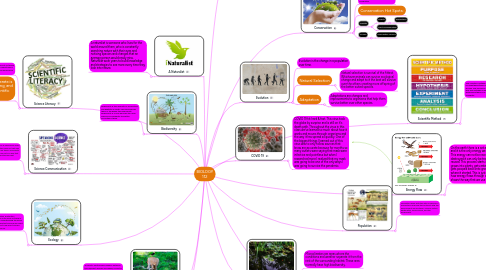BIOLOGY 112
by Caroline Owens


1. Ecology
1.1. Ecology is conservation, protection, preservation, and so much more. Ecology is about knowing and understanding the world we live in. This is important because we wont protect what we don't care about and we need this earth to live on.
2. Biodiversity
2.1. Biodiversity is this diversity of ecosystems and habitats on earth. The more species there is; the higher the biodiversity. Biodiversity is crucial because the more species and variability the better ecosystems thrive.
3. Symbiotic Relationships
3.1. Symbiotic Relationships happen between two different species and always consist in at least one species gaining health and food benefits.
4. Science Literacy
4.1. Bias: Implicit is being bias but not being aware that you are bias. Explicit bias is when you are bias and you know his so you are purposely bias.
4.2. Being scientifically literate is knowing, understanding, and being able to use scientific theories and policies.
5. Science Communication
5.1. Science communication is being open open discoveries and scientific ideas so that may minds can collaborate on these. Along with being able to put science out in a way that many people can understand and get motivated about.
6. A Naturalist
6.1. A naturalist is someone who lives for the world around them, who is constantly searching nature with their eyes and noticing species and changes that an average person would easily miss. Naturalist work years to build knowledge and strategies to see more every time they look into nature.
7. Microscope
8. Environmental Science
8.1. Environmental science is a mix of biology, ecology, chemistry, zoology and many more to create a study on the earth and all the aspects of the earth instead of one aspect in depth.
9. Energy Flow
9.1. On the earth there is a set amount of energy and it is the only energy we will ever have. This energy can not be recreated or destroyed it can only be transferred and reused. This process starts in the ground, grows into plants, gets eaten by animals, gets pooped back onto ground and is back where it started. This is just one example of how energy flows through organisms but it shows the way that we use energy.
10. Evolution
10.1. Evolution is the change in a population over time.
10.2. Natural Selection
10.2.1. Natural selection is survival of the fittest. Whichever animals can survive ecological change and adapt to it the best will survive over the others creating more offspring of the better suited species.
10.3. Adaptation
10.3.1. Adaptations are changes and improvements to organisms that help them survive better over other species.
11. Population
11.1. Population deals with the data of species n ecosystems and how they interact with the environment around them. Such as birth & death rates, food sources, and the biodiversity.
12. Microclimates
12.1. Microclimates are areas where the conditions and weather separate it from the rest of the surrounding habitat. These area normally have high biodiversity.
13. Conservation
13.1. Conservation is crucial to protecting the earth we live on. Over many years humans have lived on this earth without the idea of conservation and created a reality where conservation is the only option. Conservation is restoring, protecting, and preserving our natural resources so we don't lose them completely.
13.2. Conservation Hot Spots:
13.3. Habitats
13.3.1. Forests
13.3.1.1. Ecosystems
13.3.2. Plant Communnnties
13.4. Oceans
13.4.1. Fresh Water Sources
14. Climate Change
14.1. Climate Change is so much more than just warming. This is the idea of colder colds, hotter hots, wetter wets, dryer dries, and more extreme extremes. We as a globe have put more CO2 into the atmosphere than it can handle is it is slowly breaking our world down.
14.2. Effects of Climate Change
14.3. Rising tides and water levels
14.3.1. Extreme hurricanes
14.4. Wildfires
14.4.1. Melting Icecaps
